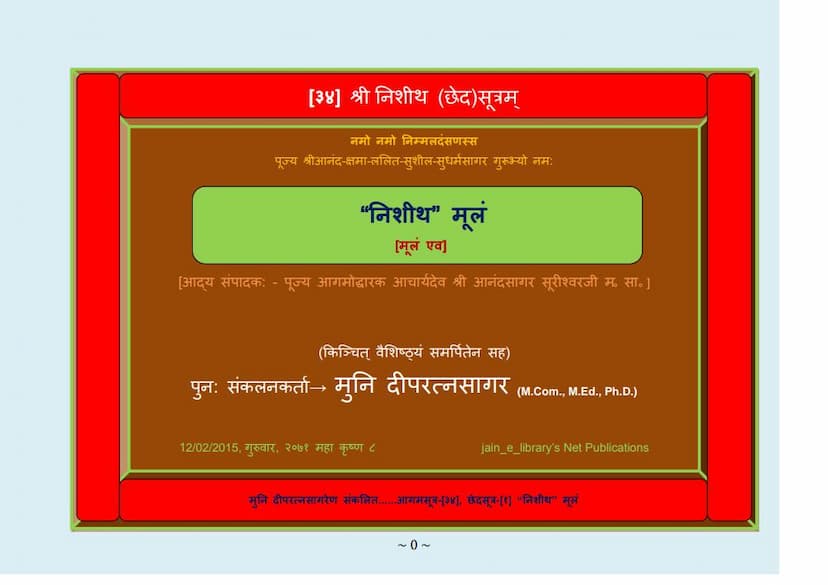Aagam 34 NISHITH Moolam Ev
Added to library: September 1, 2025

Summary
Here's a comprehensive summary of the provided Jain text, "Aagam 34 Nishith Moolam Ev," compiled by Muni Dippratnasagar and edited by Acharya Anandasagar Surishwarji:
Book Title: Aagam 34 Nishith Moolam Ev Author(s)/Compiler: Muni Dippratnasagar Editor/Reviser: Acharya Anandasagar Surishwarji (also referred to as Sagar Ananda Suri Ji) Publisher: Deepratnasagar (as part of jain_e_library's Net Publications) Language: Primarily Prakrit (original text), with introductory and explanatory material in Hindi. Subject: This text is the first Chedsūtra (छेदसूत्र), named "Nishith" (निशीथ), which is part of the Jain Agamas (sacred scriptures). Shedsūtras deal with the rules of conduct, discipline, and expiation for ascetics.
Core Purpose and Context:
The publication aims to present the original (Moolam) text of the Nishith Chedsūtra, a crucial scripture for Jain monks and nuns. It is presented with a focus on preserving the original form while making it accessible through modern means. The effort is a tribute to the legacy of Acharya Anandasagar Surishwarji, who previously undertook extensive work on the Jain Agamas.
Key Features and Content:
-
Original Text Preservation: The primary goal is to present the "Moolam" (मूलं) or original text of the Nishith Chedsūtra. This means it aims to reproduce the canonical verses as they are.
-
Editorial and Compilational Work:
- Acharya Anandasagar Surishwarji (Sagar Ananda Suri Ji): This edition is based on his significant prior work. He had previously revised and edited 45 Agamas along with two additional Agamas, five Niyuktis, and the Kalpasūtra, compiled into a monumental work called "Agamam-anjusha" (आगममंजुषा) around 1942 (Vikram Samvat 1998). This "Agamam-anjusha" was also inscribed on stone tablets at Shatrunjay Tirth and on copper plates in Suratnagar.
- Muni Dippratnasagar: The current compiler has taken the 6+1 Chedsūtras that were part of Acharya Anandasagar Surishwarji's "Agamam-anjusha," photo-scanned them, and recompiled them. He has organized them into individual volumes and made them available digitally. He expresses a desire to print them later.
-
Accessibility and Digital Format:
- The text is published digitally through jain_e_library.org's "Net Publications." This is seen as a simple, affordable, and modern way to reach a global audience.
- The content has also been compiled into separate A4-sized books and included in DVDs.
-
Structure and Navigation:
- "Dip Anukram" (दीप अनुक्रम): A unique indexing system called "Dip Anukram" has been created. This system aims to provide a consistent reference point across various Jain Agama publications (in Prakrit, Sanskrit, Hindi, Gujarati, English, etc.) compiled by the same lineage.
- Verse/Gatha Identification: The text clearly indicates whether a passage is a "Sutra" (सूत्र) (marked with parentheses
()) or a "Gatha" (गाथा) (marked with||-||or the word "Gatha"). - Index/Anukramanika: An index is provided that lists each "Adhyayan" (adhyay, chapter/section) or "Uddeshak" (उद्देश, topic of discussion) along with the corresponding page numbers from Acharya Anandasagar Surishwarji's edition. This helps researchers quickly access specific topics.
- Footnotes: Footnotes are included at the bottom of many pages to provide additional information about the subject matter, identify printing errors in the original edition, or clarify numbering issues.
-
Motivation for the Publication:
- Service to Agamas: The compiler, Muni Dippratnasagar, has a deep commitment to serving the Jain Agamas, having already published 45 Agamas in 30 volumes (over 12,700 pages).
- Honoring Acharya Anandasagar Surishwarji: The primary motivation for re-presenting these Chedsūtras is the profound respect and faith people have in Acharya Sagar Ananda Surishwarji.
- Completeness: By including these 6+1 Chedsūtras, the publisher ensures that their collection of Agamas is considered complete and not just limited to the 39 main Agamas.
-
Content Overview (from page samples): The "Nishith" Sutra, as presented, is a detailed text that delineates specific rules and prohibitions for Jain ascetics. The sampled pages reveal discussions on:
- Hygiene and Cleanliness: Rules regarding bathing, washing hands and feet, cleaning the body, using toothpicks, ear picks, and nail cleaners.
- Food and Drink: Regulations concerning the consumption of various foods, whether permitted or prohibited, and how they should be prepared or handled.
- Possessions and Utensils: Rules about carrying and using specific items like needles, pots, cloths, and other personal belongings.
- Conduct and Behavior: Guidelines on interactions with laypeople, the proper way to beg for alms, prohibited actions (like wasting water, using items improperly), and the consequences of breaking rules.
- Specific Situations: Rules pertaining to different environments, seasons, and circumstances that ascetics might encounter.
- Expiaory Rites (Prayashchitta): While not explicitly detailed in the samples, Chedsūtras are primarily about the penances and expiations required for transgressions. The detailed rules likely lead to understanding these expiatory measures.
Overall Significance:
This publication of the "Nishith" Chedsūtra is a significant contribution to the study and practice of Jainism. It makes an essential scriptural text accessible to a wider audience through modern means, while honoring the monumental efforts of previous Acharyas. The detailed indexing and cross-referencing systems enhance its usability for scholars and practitioners alike. The work underscores the rigorous discipline and ethical framework that underpins the ascetic life in Jainism.